Laureate: MIS604 Requirement Engineering Specification Report
VerifiedAdded on 2022/10/11
|10
|1895
|41
Report
AI Summary
This report is a requirement specification for the MIS604 Requirement Engineering course at Laureate International Universities. The assignment involves developing a mobile app/web-based system for a company named ABC Pty Ltd that provides services to demand trades and handyman customers. The report includes an overall description of the system, detailing its product perspective, user classes, operating environment, design constraints, and assumptions. It also outlines the system's features, such as registration, login, dashboard, and payment features, along with use case diagrams, specifications for selected use cases (like payment), swim lane diagrams, state-transition diagrams, and dialog maps. The report incorporates references to relevant literature and provides a comprehensive analysis of the system's requirements and functionalities.
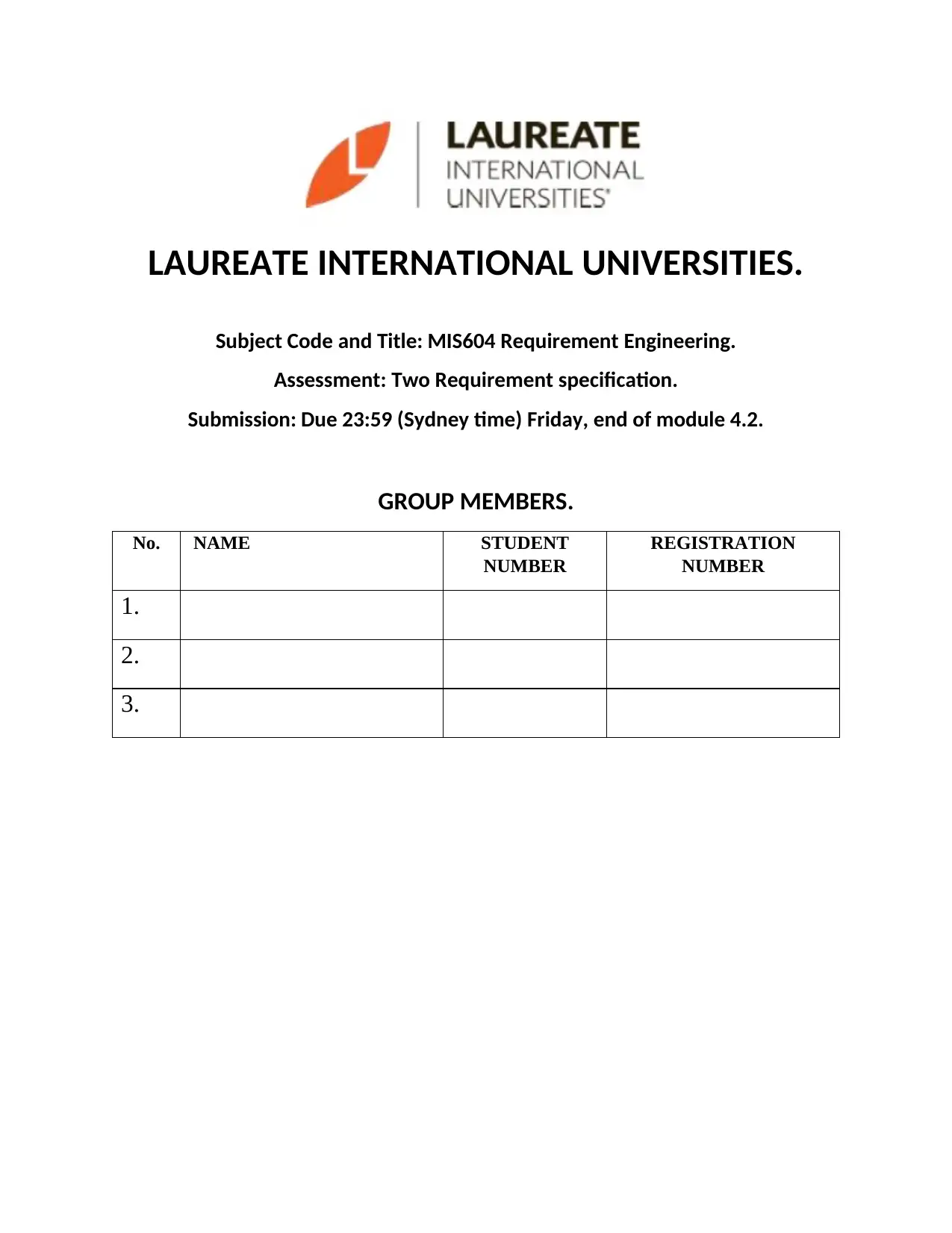
LAUREATE INTERNATIONAL UNIVERSITIES.
Subject Code and Title: MIS604 Requirement Engineering.
Assessment: Two Requirement specification.
Submission: Due 23:59 (Sydney time) Friday, end of module 4.2.
GROUP MEMBERS.
No. NAME STUDENT
NUMBER
REGISTRATION
NUMBER
1.
2.
3.
Subject Code and Title: MIS604 Requirement Engineering.
Assessment: Two Requirement specification.
Submission: Due 23:59 (Sydney time) Friday, end of module 4.2.
GROUP MEMBERS.
No. NAME STUDENT
NUMBER
REGISTRATION
NUMBER
1.
2.
3.
Paraphrase This Document
Need a fresh take? Get an instant paraphrase of this document with our AI Paraphraser
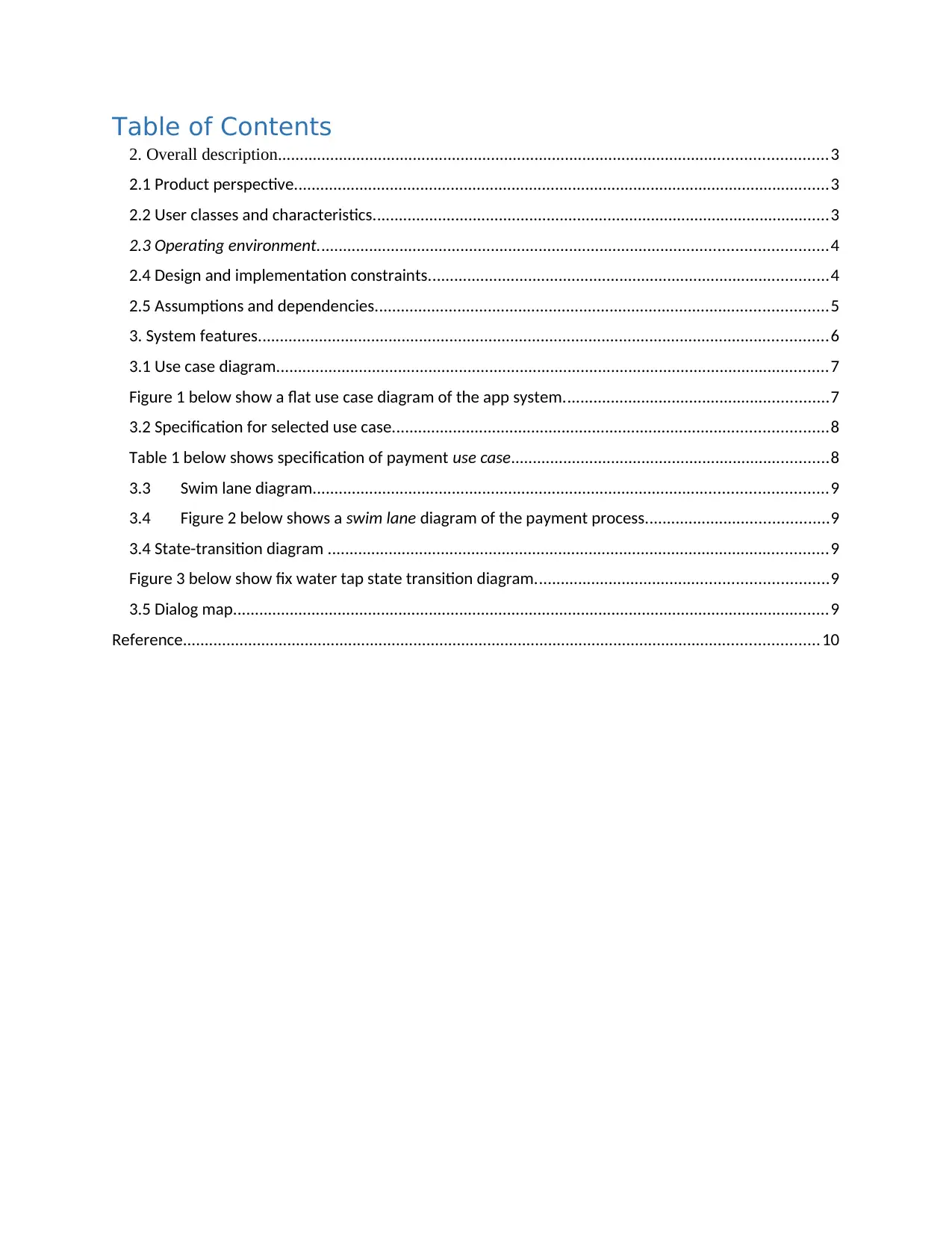
Table of Contents
2. Overall description..............................................................................................................................3
2.1 Product perspective...........................................................................................................................3
2.2 User classes and characteristics.........................................................................................................3
2.3 Operating environment.....................................................................................................................4
2.4 Design and implementation constraints............................................................................................4
2.5 Assumptions and dependencies........................................................................................................5
3. System features...................................................................................................................................6
3.1 Use case diagram...............................................................................................................................7
Figure 1 below show a flat use case diagram of the app system.............................................................7
3.2 Specification for selected use case....................................................................................................8
Table 1 below shows specification of payment use case.........................................................................8
3.3 Swim lane diagram......................................................................................................................9
3.4 Figure 2 below shows a swim lane diagram of the payment process..........................................9
3.4 State-transition diagram ...................................................................................................................9
Figure 3 below show fix water tap state transition diagram...................................................................9
3.5 Dialog map.........................................................................................................................................9
Reference..................................................................................................................................................10
2. Overall description..............................................................................................................................3
2.1 Product perspective...........................................................................................................................3
2.2 User classes and characteristics.........................................................................................................3
2.3 Operating environment.....................................................................................................................4
2.4 Design and implementation constraints............................................................................................4
2.5 Assumptions and dependencies........................................................................................................5
3. System features...................................................................................................................................6
3.1 Use case diagram...............................................................................................................................7
Figure 1 below show a flat use case diagram of the app system.............................................................7
3.2 Specification for selected use case....................................................................................................8
Table 1 below shows specification of payment use case.........................................................................8
3.3 Swim lane diagram......................................................................................................................9
3.4 Figure 2 below shows a swim lane diagram of the payment process..........................................9
3.4 State-transition diagram ...................................................................................................................9
Figure 3 below show fix water tap state transition diagram...................................................................9
3.5 Dialog map.........................................................................................................................................9
Reference..................................................................................................................................................10
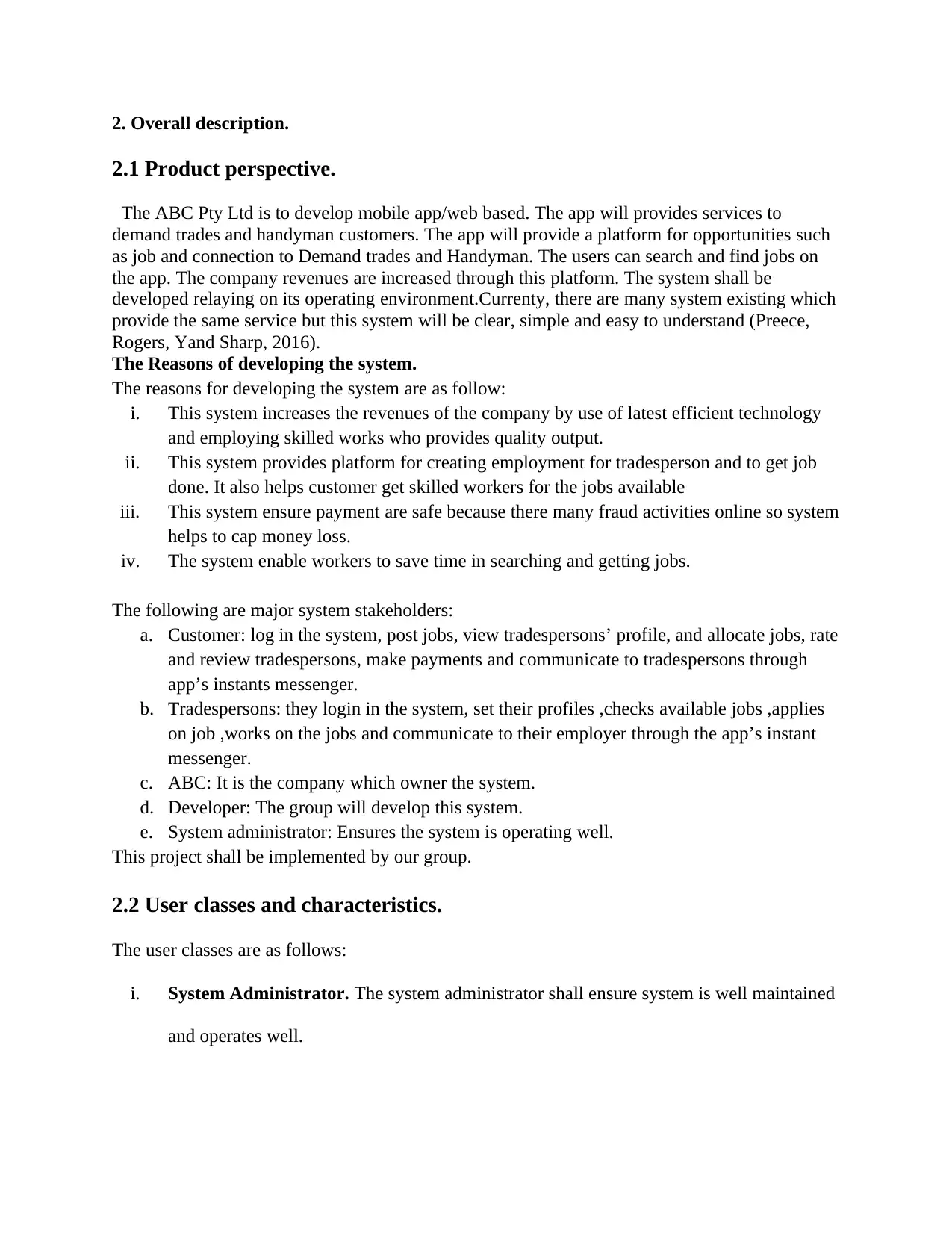
2. Overall description.
2.1 Product perspective.
The ABC Pty Ltd is to develop mobile app/web based. The app will provides services to
demand trades and handyman customers. The app will provide a platform for opportunities such
as job and connection to Demand trades and Handyman. The users can search and find jobs on
the app. The company revenues are increased through this platform. The system shall be
developed relaying on its operating environment.Currenty, there are many system existing which
provide the same service but this system will be clear, simple and easy to understand (Preece,
Rogers, Yand Sharp, 2016).
The Reasons of developing the system.
The reasons for developing the system are as follow:
i. This system increases the revenues of the company by use of latest efficient technology
and employing skilled works who provides quality output.
ii. This system provides platform for creating employment for tradesperson and to get job
done. It also helps customer get skilled workers for the jobs available
iii. This system ensure payment are safe because there many fraud activities online so system
helps to cap money loss.
iv. The system enable workers to save time in searching and getting jobs.
The following are major system stakeholders:
a. Customer: log in the system, post jobs, view tradespersons’ profile, and allocate jobs, rate
and review tradespersons, make payments and communicate to tradespersons through
app’s instants messenger.
b. Tradespersons: they login in the system, set their profiles ,checks available jobs ,applies
on job ,works on the jobs and communicate to their employer through the app’s instant
messenger.
c. ABC: It is the company which owner the system.
d. Developer: The group will develop this system.
e. System administrator: Ensures the system is operating well.
This project shall be implemented by our group.
2.2 User classes and characteristics.
The user classes are as follows:
i. System Administrator. The system administrator shall ensure system is well maintained
and operates well.
2.1 Product perspective.
The ABC Pty Ltd is to develop mobile app/web based. The app will provides services to
demand trades and handyman customers. The app will provide a platform for opportunities such
as job and connection to Demand trades and Handyman. The users can search and find jobs on
the app. The company revenues are increased through this platform. The system shall be
developed relaying on its operating environment.Currenty, there are many system existing which
provide the same service but this system will be clear, simple and easy to understand (Preece,
Rogers, Yand Sharp, 2016).
The Reasons of developing the system.
The reasons for developing the system are as follow:
i. This system increases the revenues of the company by use of latest efficient technology
and employing skilled works who provides quality output.
ii. This system provides platform for creating employment for tradesperson and to get job
done. It also helps customer get skilled workers for the jobs available
iii. This system ensure payment are safe because there many fraud activities online so system
helps to cap money loss.
iv. The system enable workers to save time in searching and getting jobs.
The following are major system stakeholders:
a. Customer: log in the system, post jobs, view tradespersons’ profile, and allocate jobs, rate
and review tradespersons, make payments and communicate to tradespersons through
app’s instants messenger.
b. Tradespersons: they login in the system, set their profiles ,checks available jobs ,applies
on job ,works on the jobs and communicate to their employer through the app’s instant
messenger.
c. ABC: It is the company which owner the system.
d. Developer: The group will develop this system.
e. System administrator: Ensures the system is operating well.
This project shall be implemented by our group.
2.2 User classes and characteristics.
The user classes are as follows:
i. System Administrator. The system administrator shall ensure system is well maintained
and operates well.
⊘ This is a preview!⊘
Do you want full access?
Subscribe today to unlock all pages.

Trusted by 1+ million students worldwide
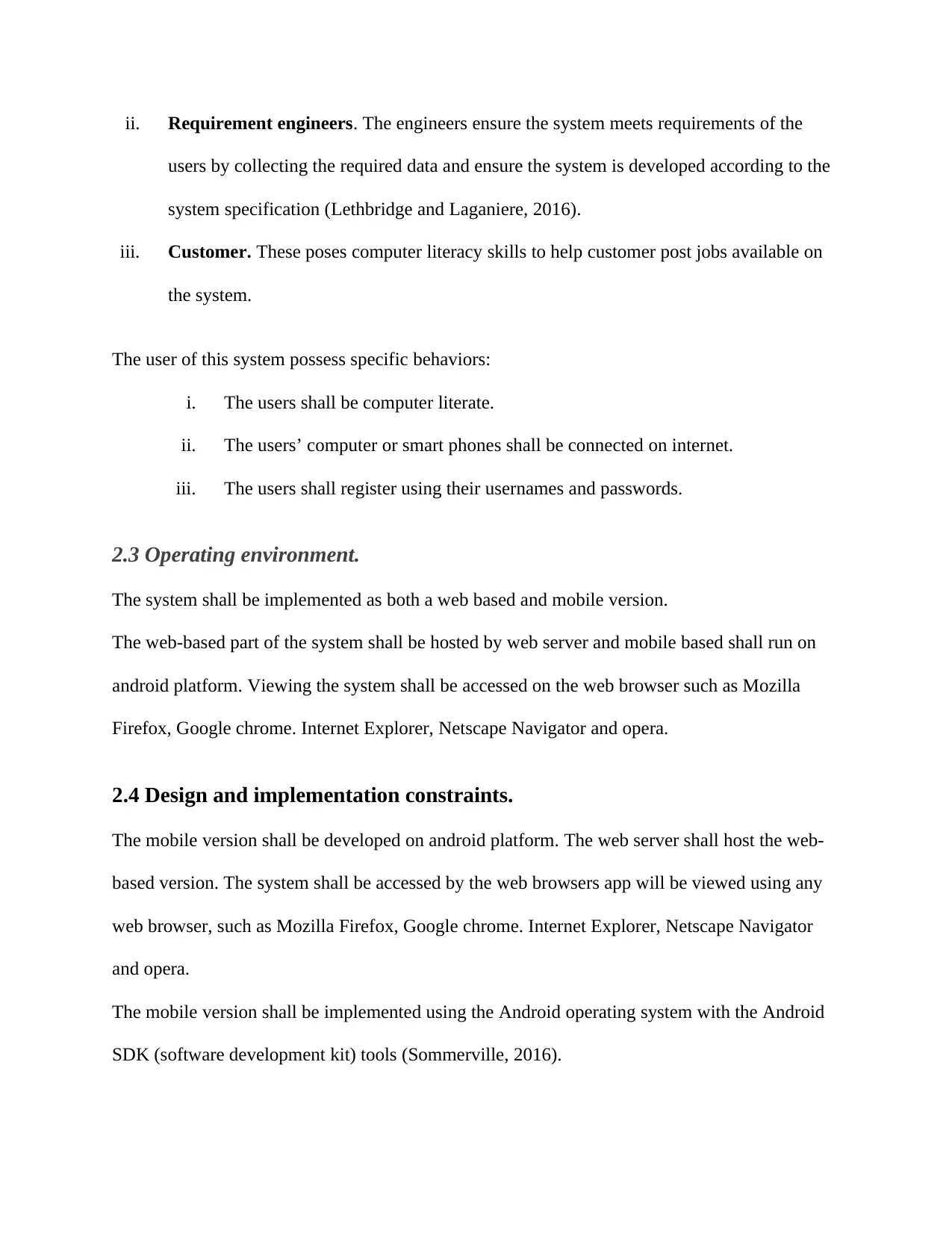
ii. Requirement engineers. The engineers ensure the system meets requirements of the
users by collecting the required data and ensure the system is developed according to the
system specification (Lethbridge and Laganiere, 2016).
iii. Customer. These poses computer literacy skills to help customer post jobs available on
the system.
The user of this system possess specific behaviors:
i. The users shall be computer literate.
ii. The users’ computer or smart phones shall be connected on internet.
iii. The users shall register using their usernames and passwords.
2.3 Operating environment.
The system shall be implemented as both a web based and mobile version.
The web-based part of the system shall be hosted by web server and mobile based shall run on
android platform. Viewing the system shall be accessed on the web browser such as Mozilla
Firefox, Google chrome. Internet Explorer, Netscape Navigator and opera.
2.4 Design and implementation constraints.
The mobile version shall be developed on android platform. The web server shall host the web-
based version. The system shall be accessed by the web browsers app will be viewed using any
web browser, such as Mozilla Firefox, Google chrome. Internet Explorer, Netscape Navigator
and opera.
The mobile version shall be implemented using the Android operating system with the Android
SDK (software development kit) tools (Sommerville, 2016).
users by collecting the required data and ensure the system is developed according to the
system specification (Lethbridge and Laganiere, 2016).
iii. Customer. These poses computer literacy skills to help customer post jobs available on
the system.
The user of this system possess specific behaviors:
i. The users shall be computer literate.
ii. The users’ computer or smart phones shall be connected on internet.
iii. The users shall register using their usernames and passwords.
2.3 Operating environment.
The system shall be implemented as both a web based and mobile version.
The web-based part of the system shall be hosted by web server and mobile based shall run on
android platform. Viewing the system shall be accessed on the web browser such as Mozilla
Firefox, Google chrome. Internet Explorer, Netscape Navigator and opera.
2.4 Design and implementation constraints.
The mobile version shall be developed on android platform. The web server shall host the web-
based version. The system shall be accessed by the web browsers app will be viewed using any
web browser, such as Mozilla Firefox, Google chrome. Internet Explorer, Netscape Navigator
and opera.
The mobile version shall be implemented using the Android operating system with the Android
SDK (software development kit) tools (Sommerville, 2016).
Paraphrase This Document
Need a fresh take? Get an instant paraphrase of this document with our AI Paraphraser
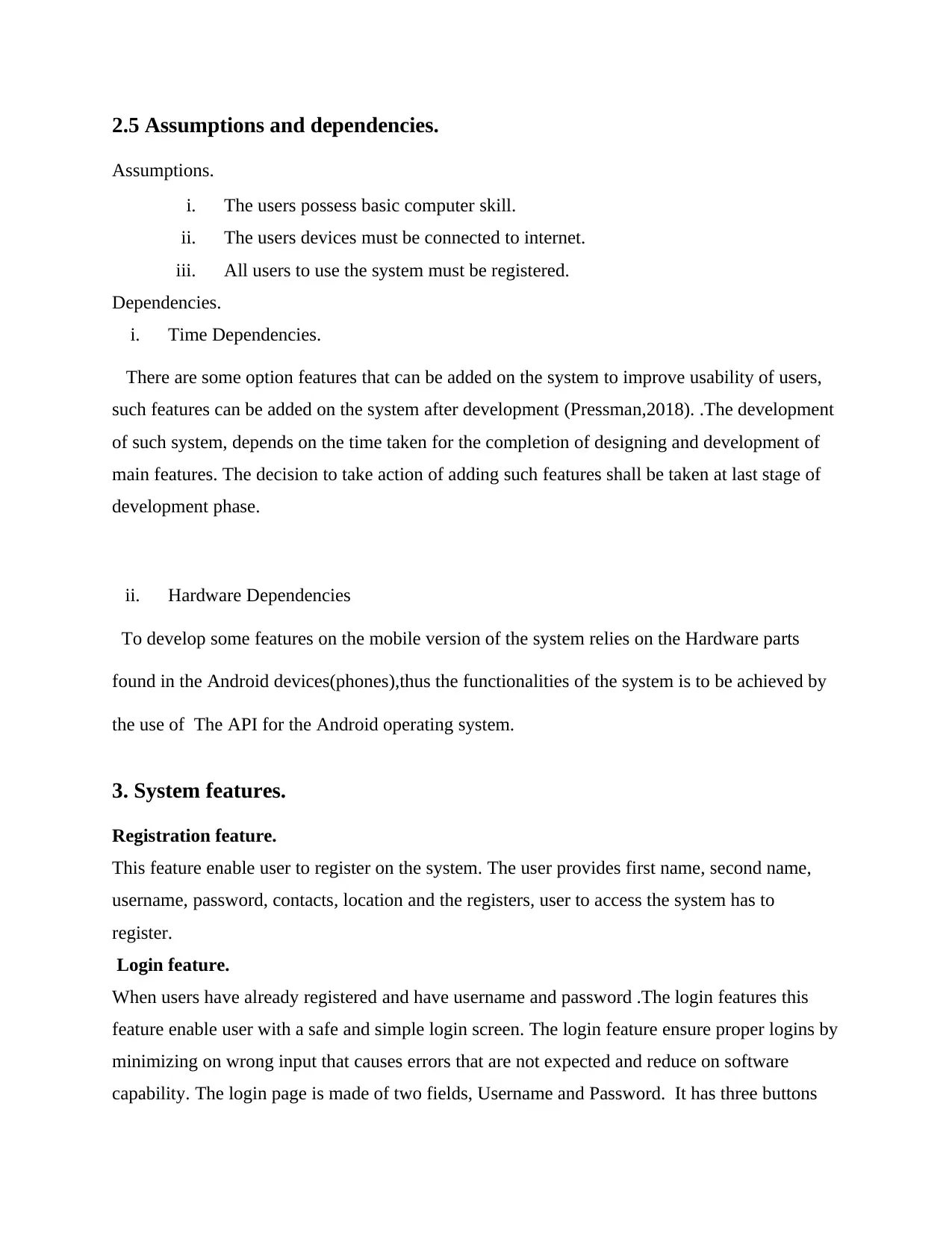
2.5 Assumptions and dependencies.
Assumptions.
i. The users possess basic computer skill.
ii. The users devices must be connected to internet.
iii. All users to use the system must be registered.
Dependencies.
i. Time Dependencies.
There are some option features that can be added on the system to improve usability of users,
such features can be added on the system after development (Pressman,2018). .The development
of such system, depends on the time taken for the completion of designing and development of
main features. The decision to take action of adding such features shall be taken at last stage of
development phase.
ii. Hardware Dependencies
To develop some features on the mobile version of the system relies on the Hardware parts
found in the Android devices(phones),thus the functionalities of the system is to be achieved by
the use of The API for the Android operating system.
3. System features.
Registration feature.
This feature enable user to register on the system. The user provides first name, second name,
username, password, contacts, location and the registers, user to access the system has to
register.
Login feature.
When users have already registered and have username and password .The login features this
feature enable user with a safe and simple login screen. The login feature ensure proper logins by
minimizing on wrong input that causes errors that are not expected and reduce on software
capability. The login page is made of two fields, Username and Password. It has three buttons
Assumptions.
i. The users possess basic computer skill.
ii. The users devices must be connected to internet.
iii. All users to use the system must be registered.
Dependencies.
i. Time Dependencies.
There are some option features that can be added on the system to improve usability of users,
such features can be added on the system after development (Pressman,2018). .The development
of such system, depends on the time taken for the completion of designing and development of
main features. The decision to take action of adding such features shall be taken at last stage of
development phase.
ii. Hardware Dependencies
To develop some features on the mobile version of the system relies on the Hardware parts
found in the Android devices(phones),thus the functionalities of the system is to be achieved by
the use of The API for the Android operating system.
3. System features.
Registration feature.
This feature enable user to register on the system. The user provides first name, second name,
username, password, contacts, location and the registers, user to access the system has to
register.
Login feature.
When users have already registered and have username and password .The login features this
feature enable user with a safe and simple login screen. The login feature ensure proper logins by
minimizing on wrong input that causes errors that are not expected and reduce on software
capability. The login page is made of two fields, Username and Password. It has three buttons
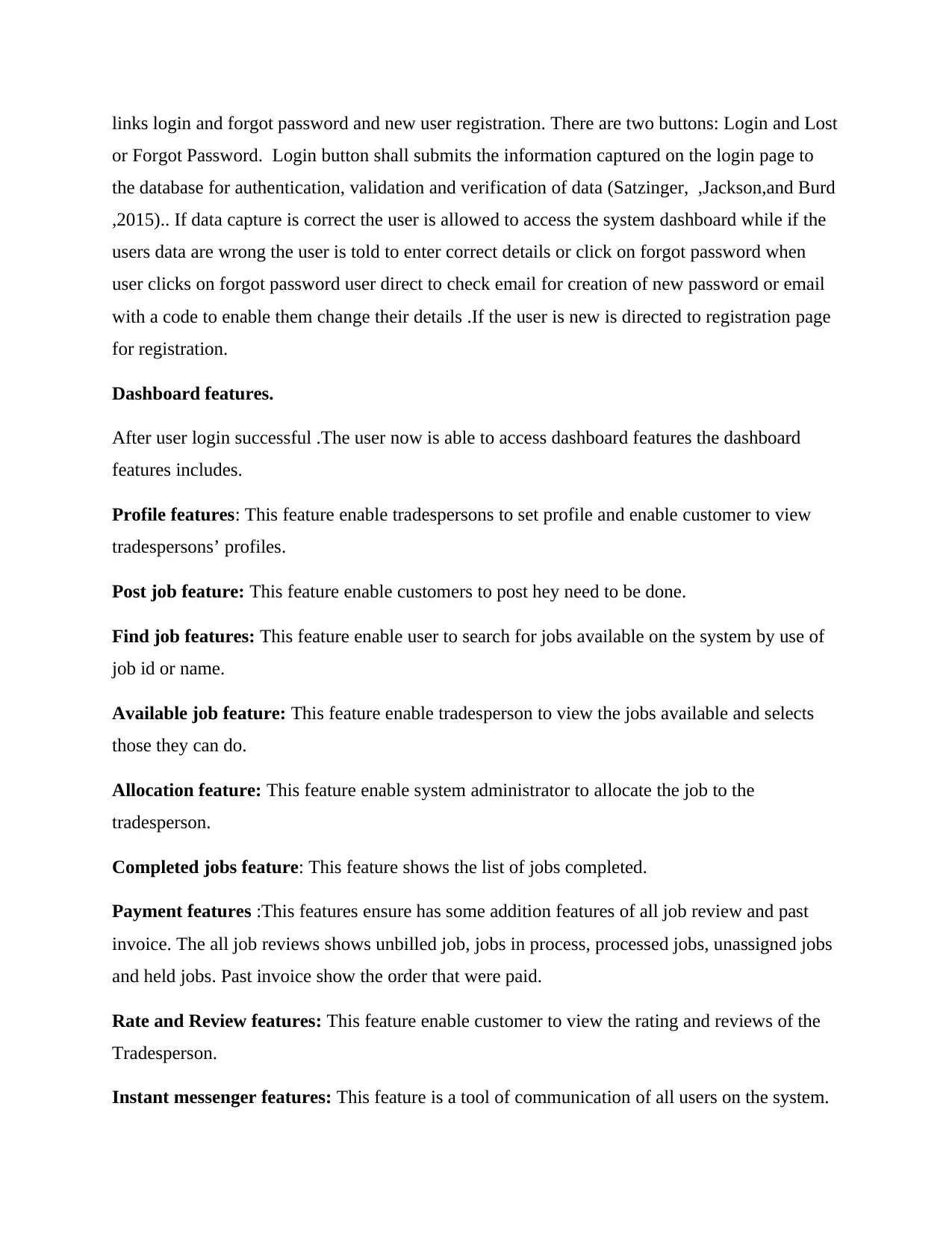
links login and forgot password and new user registration. There are two buttons: Login and Lost
or Forgot Password. Login button shall submits the information captured on the login page to
the database for authentication, validation and verification of data (Satzinger, ,Jackson,and Burd
,2015).. If data capture is correct the user is allowed to access the system dashboard while if the
users data are wrong the user is told to enter correct details or click on forgot password when
user clicks on forgot password user direct to check email for creation of new password or email
with a code to enable them change their details .If the user is new is directed to registration page
for registration.
Dashboard features.
After user login successful .The user now is able to access dashboard features the dashboard
features includes.
Profile features: This feature enable tradespersons to set profile and enable customer to view
tradespersons’ profiles.
Post job feature: This feature enable customers to post hey need to be done.
Find job features: This feature enable user to search for jobs available on the system by use of
job id or name.
Available job feature: This feature enable tradesperson to view the jobs available and selects
those they can do.
Allocation feature: This feature enable system administrator to allocate the job to the
tradesperson.
Completed jobs feature: This feature shows the list of jobs completed.
Payment features :This features ensure has some addition features of all job review and past
invoice. The all job reviews shows unbilled job, jobs in process, processed jobs, unassigned jobs
and held jobs. Past invoice show the order that were paid.
Rate and Review features: This feature enable customer to view the rating and reviews of the
Tradesperson.
Instant messenger features: This feature is a tool of communication of all users on the system.
or Forgot Password. Login button shall submits the information captured on the login page to
the database for authentication, validation and verification of data (Satzinger, ,Jackson,and Burd
,2015).. If data capture is correct the user is allowed to access the system dashboard while if the
users data are wrong the user is told to enter correct details or click on forgot password when
user clicks on forgot password user direct to check email for creation of new password or email
with a code to enable them change their details .If the user is new is directed to registration page
for registration.
Dashboard features.
After user login successful .The user now is able to access dashboard features the dashboard
features includes.
Profile features: This feature enable tradespersons to set profile and enable customer to view
tradespersons’ profiles.
Post job feature: This feature enable customers to post hey need to be done.
Find job features: This feature enable user to search for jobs available on the system by use of
job id or name.
Available job feature: This feature enable tradesperson to view the jobs available and selects
those they can do.
Allocation feature: This feature enable system administrator to allocate the job to the
tradesperson.
Completed jobs feature: This feature shows the list of jobs completed.
Payment features :This features ensure has some addition features of all job review and past
invoice. The all job reviews shows unbilled job, jobs in process, processed jobs, unassigned jobs
and held jobs. Past invoice show the order that were paid.
Rate and Review features: This feature enable customer to view the rating and reviews of the
Tradesperson.
Instant messenger features: This feature is a tool of communication of all users on the system.
⊘ This is a preview!⊘
Do you want full access?
Subscribe today to unlock all pages.

Trusted by 1+ million students worldwide
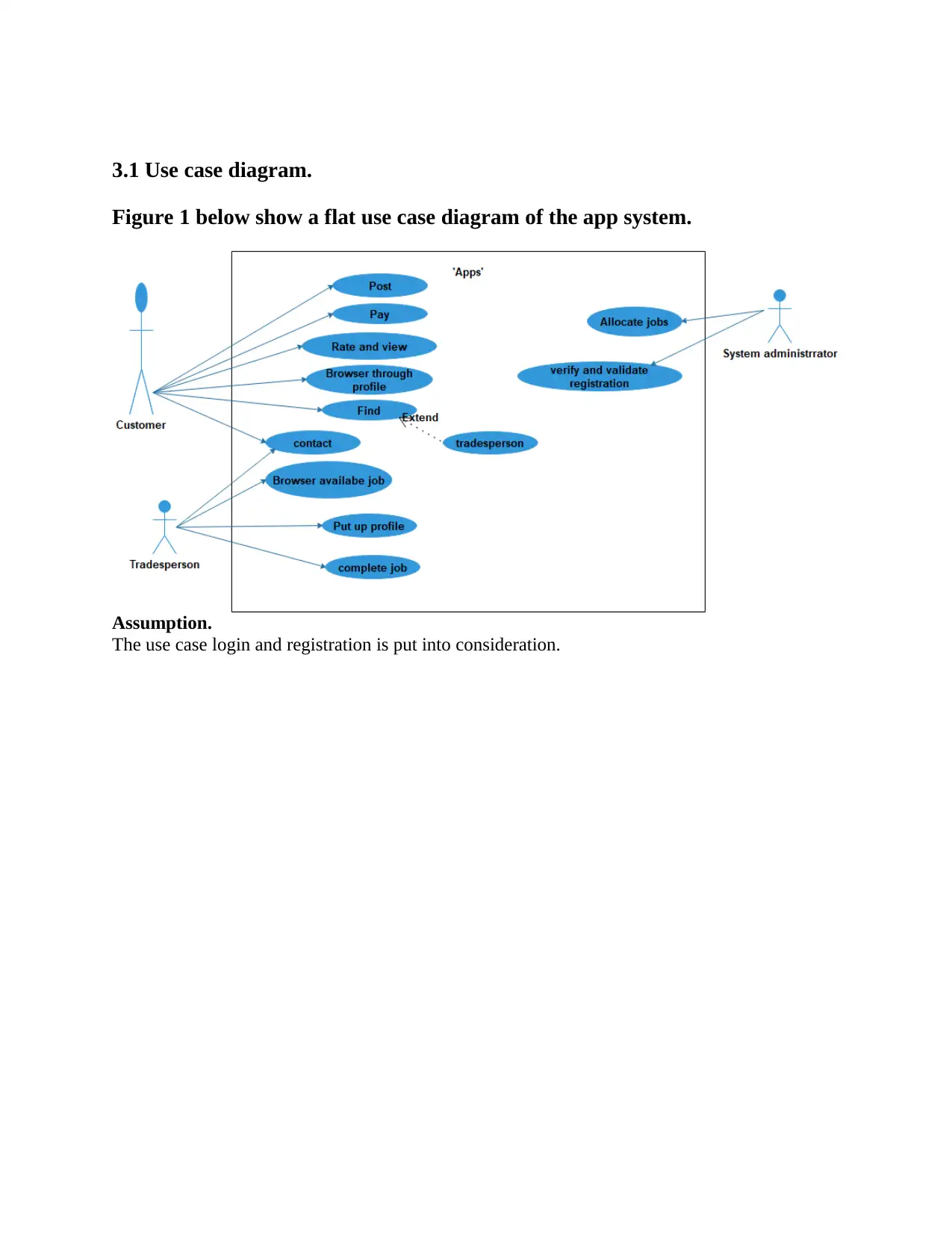
3.1 Use case diagram.
Figure 1 below show a flat use case diagram of the app system.
Assumption.
The use case login and registration is put into consideration.
Figure 1 below show a flat use case diagram of the app system.
Assumption.
The use case login and registration is put into consideration.
Paraphrase This Document
Need a fresh take? Get an instant paraphrase of this document with our AI Paraphraser
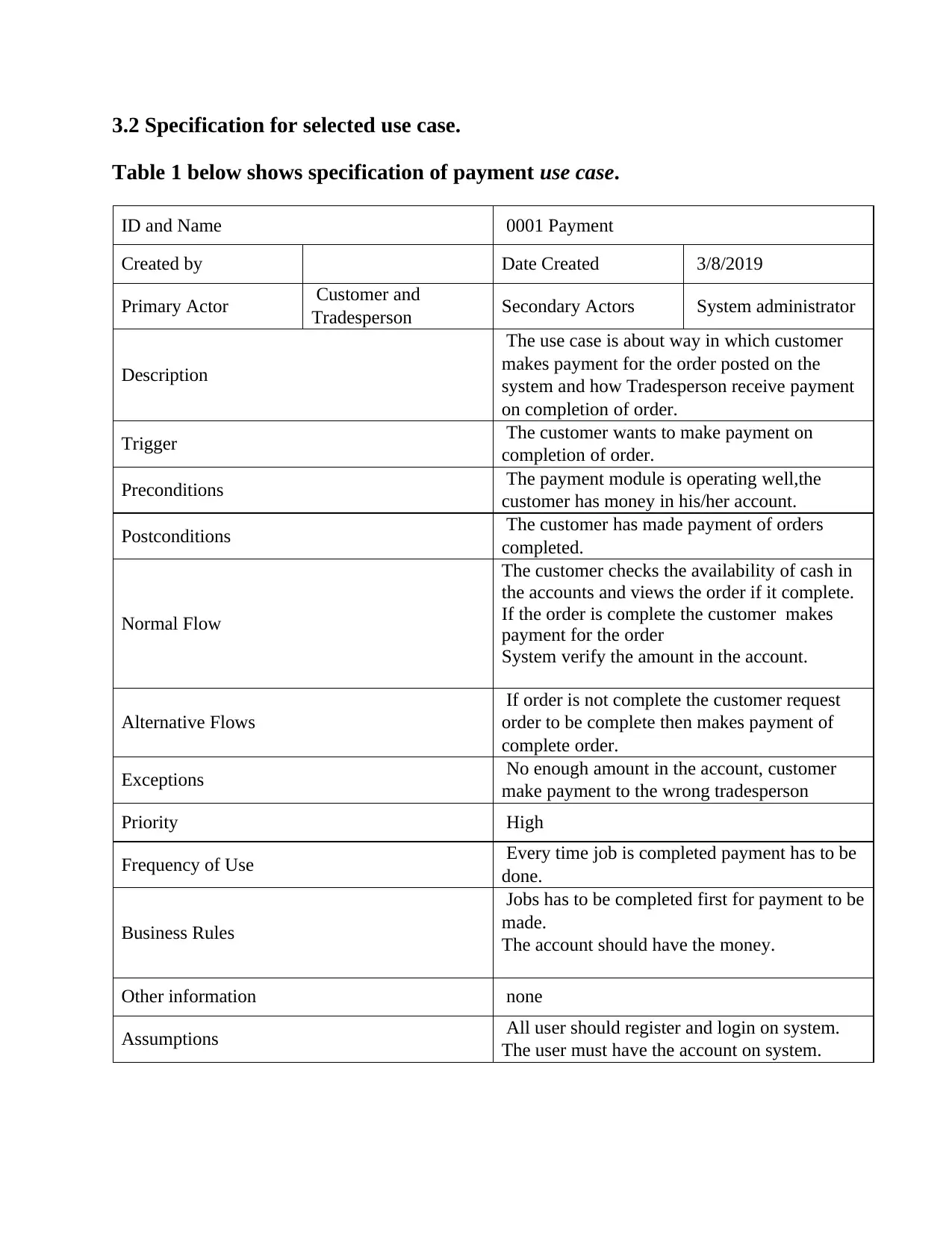
3.2 Specification for selected use case.
Table 1 below shows specification of payment use case.
ID and Name 0001 Payment
Created by Date Created 3/8/2019
Primary Actor Customer and
Tradesperson Secondary Actors System administrator
Description
The use case is about way in which customer
makes payment for the order posted on the
system and how Tradesperson receive payment
on completion of order.
Trigger The customer wants to make payment on
completion of order.
Preconditions The payment module is operating well,the
customer has money in his/her account.
Postconditions The customer has made payment of orders
completed.
Normal Flow
The customer checks the availability of cash in
the accounts and views the order if it complete.
If the order is complete the customer makes
payment for the order
System verify the amount in the account.
Alternative Flows
If order is not complete the customer request
order to be complete then makes payment of
complete order.
Exceptions No enough amount in the account, customer
make payment to the wrong tradesperson
Priority High
Frequency of Use Every time job is completed payment has to be
done.
Business Rules
Jobs has to be completed first for payment to be
made.
The account should have the money.
Other information none
Assumptions All user should register and login on system.
The user must have the account on system.
Table 1 below shows specification of payment use case.
ID and Name 0001 Payment
Created by Date Created 3/8/2019
Primary Actor Customer and
Tradesperson Secondary Actors System administrator
Description
The use case is about way in which customer
makes payment for the order posted on the
system and how Tradesperson receive payment
on completion of order.
Trigger The customer wants to make payment on
completion of order.
Preconditions The payment module is operating well,the
customer has money in his/her account.
Postconditions The customer has made payment of orders
completed.
Normal Flow
The customer checks the availability of cash in
the accounts and views the order if it complete.
If the order is complete the customer makes
payment for the order
System verify the amount in the account.
Alternative Flows
If order is not complete the customer request
order to be complete then makes payment of
complete order.
Exceptions No enough amount in the account, customer
make payment to the wrong tradesperson
Priority High
Frequency of Use Every time job is completed payment has to be
done.
Business Rules
Jobs has to be completed first for payment to be
made.
The account should have the money.
Other information none
Assumptions All user should register and login on system.
The user must have the account on system.
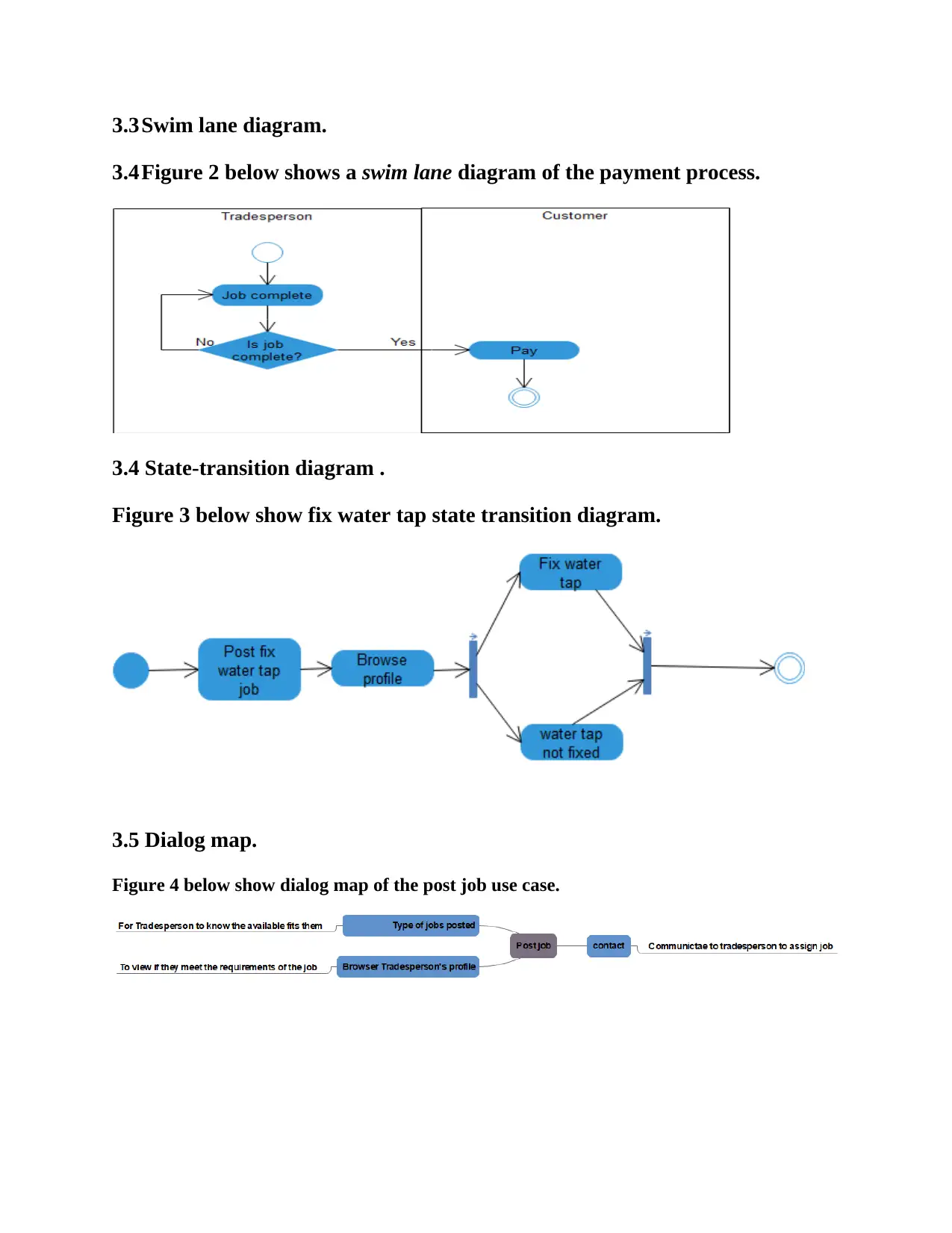
3.3Swim lane diagram.
3.4Figure 2 below shows a swim lane diagram of the payment process.
3.4 State-transition diagram .
Figure 3 below show fix water tap state transition diagram.
3.5 Dialog map.
Figure 4 below show dialog map of the post job use case.
3.4Figure 2 below shows a swim lane diagram of the payment process.
3.4 State-transition diagram .
Figure 3 below show fix water tap state transition diagram.
3.5 Dialog map.
Figure 4 below show dialog map of the post job use case.
⊘ This is a preview!⊘
Do you want full access?
Subscribe today to unlock all pages.

Trusted by 1+ million students worldwide
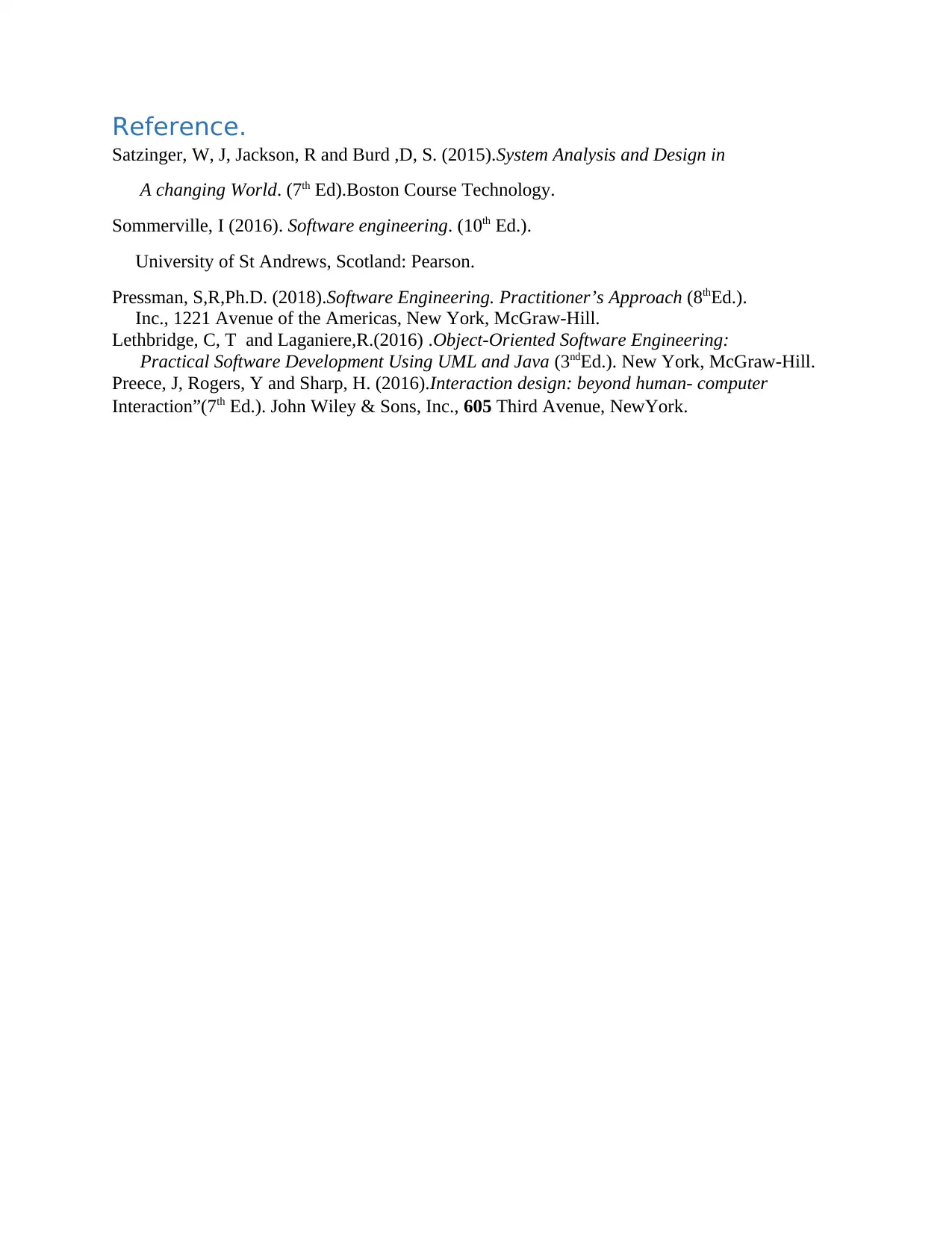
Reference.
Satzinger, W, J, Jackson, R and Burd ,D, S. (2015).System Analysis and Design in
A changing World. (7th Ed).Boston Course Technology.
Sommerville, I (2016). Software engineering. (10th Ed.).
University of St Andrews, Scotland: Pearson.
Pressman, S,R,Ph.D. (2018).Software Engineering. Practitioner’s Approach (8thEd.).
Inc., 1221 Avenue of the Americas, New York, McGraw-Hill.
Lethbridge, C, T and Laganiere,R.(2016) .Object-Oriented Software Engineering:
Practical Software Development Using UML and Java (3ndEd.). New York, McGraw-Hill.
Preece, J, Rogers, Y and Sharp, H. (2016).Interaction design: beyond human- computer
Interaction”(7th Ed.). John Wiley & Sons, Inc., 605 Third Avenue, NewYork.
Satzinger, W, J, Jackson, R and Burd ,D, S. (2015).System Analysis and Design in
A changing World. (7th Ed).Boston Course Technology.
Sommerville, I (2016). Software engineering. (10th Ed.).
University of St Andrews, Scotland: Pearson.
Pressman, S,R,Ph.D. (2018).Software Engineering. Practitioner’s Approach (8thEd.).
Inc., 1221 Avenue of the Americas, New York, McGraw-Hill.
Lethbridge, C, T and Laganiere,R.(2016) .Object-Oriented Software Engineering:
Practical Software Development Using UML and Java (3ndEd.). New York, McGraw-Hill.
Preece, J, Rogers, Y and Sharp, H. (2016).Interaction design: beyond human- computer
Interaction”(7th Ed.). John Wiley & Sons, Inc., 605 Third Avenue, NewYork.
1 out of 10
Related Documents
Your All-in-One AI-Powered Toolkit for Academic Success.
+13062052269
info@desklib.com
Available 24*7 on WhatsApp / Email
![[object Object]](/_next/static/media/star-bottom.7253800d.svg)
Unlock your academic potential
Copyright © 2020–2025 A2Z Services. All Rights Reserved. Developed and managed by ZUCOL.





